How to Saddle a Horse
"Instructions on how to saddle your horse."

Are you a new horse owner needing some assistance on how to saddle a horse?
Unless you're prone to riding bareback, you will need to properly saddle your horse for your ride. To begin, you need to first groom your horse. For the horse's comfort you want to make sure the coat is free of any mud, dirt or hair clumps that can become irritating under the saddle when being ridden.

Check to make sure there are no sores on your horse's back or cinch area. If there are saddle sores present, use extra padding or a girth pad. Though you may want to consider letting the sores heal before riding again.
Note: Saddling your horse is normally done from the left (near side) of your horse.
Make sure the saddle blanket is also clean and free of debris and is dry. Place the saddle blanket well forward and pull it back toward the rear of the horse so the front of the pad rests just in front of the withers. Always slide the blanket with the horse's hair and not against it to prevent any hair from getting clumped under the blanket. Be sure to use a large enough blanket so it shows all the way around the outside of the saddle. Using too small of a blanket will not adequately protect your horse from the saddle and make it very uncomfortable.
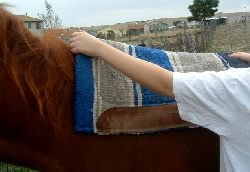

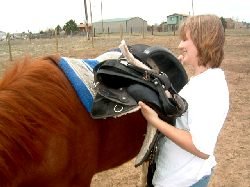
Before swinging the saddle up and over the horse's back, place the right stirrup and cinch over the seat so they do not hit and startle your horse. Hook the right stirrup on the saddle horn to hold it in place. Ensure you lift the saddle high enough so none of the flaps hit your horse. Gently lower the saddle onto your horse's back. Place the saddle so at least an inch of blanket is in front. Placing the saddle too far up on the blanket will cause the blanket to work its way backward under the saddle while riding. The fork or swell should rest neatly over the withers.

Then go to the right side (offside) and lower the right stirrup and cinch (don't just toss them over so they slap the side of your horse) and to check that the blanket is centered. Always keep a hand your horse's rump when walking around to the opposite side so your horse is aware of your presence. Once the saddle is on the blanket, lift up the front part of the saddle pad to create an air pocket between the blanket and your horse's withers.
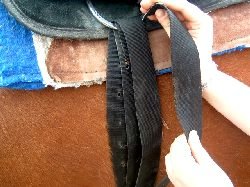
Reach under your horse's belly for the cinch or girth. Run the latigo or tie strap through the cinch ring and D-ring (rigging ring) twice. Tighten the cinch just enough so it's up against your horse's belly. Next create a loosely tied cinch knot. To make the knot, pull the latigo to one side of the D-ring, cross over the top and run it up through the D-ring again. Then pull the end of the latigo down through the loop you created.

Now slowly tighten the cinch so it is nice and snug around the horse's belly just behind the front legs. The cinch should be snug enough so you can just fit your finger between the cinch and horse's belly. Before tightening the cinch, double check that the blanket is centered and the cinch is straight and not twisted. The cinch should not be able to rub or cut into the horse's front legs. Tighten up the cinch knot and secure the end of the tie strap through the latigo carrier in front of the saddle.
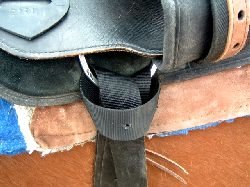
If there is a back cinch, fasten it after the front cinch is snug - the back cinch should be close to the horse's belly so it does not get caught on brush or branches, but should not be tight (your hand should be able to fit flat between the cinch and horse). There may be another strap to connect the rear cinch to the front cinch to prevent the rear cinch from interfering with the horse's back legs.
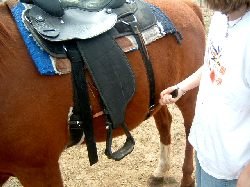
Next, walk your horse around to make it relax (some horses will puff out their stomachs and lungs when first putting on the saddle making it impossible to fully tighten the cinch) and to make sure no loose skin is trapped under the girth. Then tighten the front cinch making sure it is tighter than snug (you don't want the saddle to slide off the horse while mounting or riding). Pull your horse's legs forward to get any pinch skin out from under the girth.
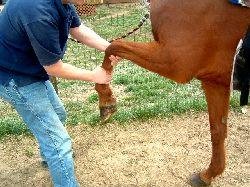
Adjust the stirrups so when you stand in the saddle, there are only about two finger widths between you and the saddle. As a rule of thumb, you can adjust the proper length of the stirrups by placing your hand at the top of the saddle fender and checking that the stirrup is just long enough to reach your armpit.




